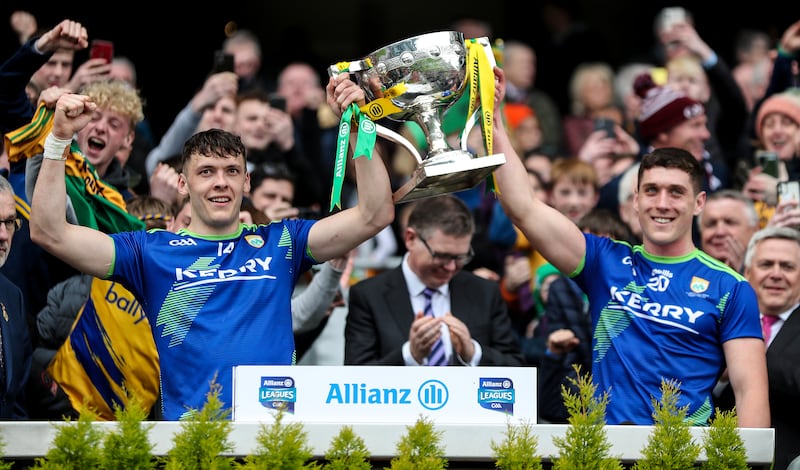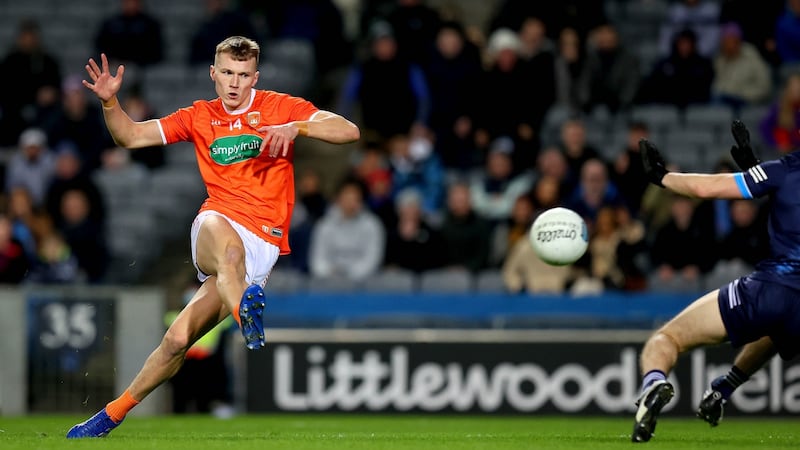Here it comes, the upside-down, the inside-out. The National Football League returns this weekend, bless its cotton socks. And its woolly hats. And its coats and snoods and its brollies and boots and everything else that might fit in the wagon. Winter is still hanging around like a maudlin party guest but the intercounty season is back so winter knows what it can do with itself.
Right around the island, people will get up and get out and go to games this weekend. From as far north as Owenbeg in Derry to Páirc Uí Chaoimh in the south. In stadiums as big as Croke Park in Dublin 3 and in grounds as cosy as Corrigan Park in Belfast BT12. People will go. Very few of them will give it any thought.
The league doesn’t really go in that much for thinking. Doesn’t reward it, at any rate. If you sat for too long trying to define the meaning of it or the worth of it or even just the basic point of it, you’d tie your brain into ampersands. It takes up 10 of the 27 weeks of the intercounty season and yet hardly anybody knows how to feel about it.
What exactly is the league? Depends what you’re asking, really. On a very basic level, it’s Gaelic football’s secondary competition. It’s nominally that in hurling too but nobody is buying that any more. The hurling league has become so thoroughly drained of jeopardy that you could make reasonable claims for the Fitzgibbon Cup ahead of it. Whatever the football league is, it’s not nothing.
READ MORE
Between now and the league finals on the first weekend of April, the four divisions will have 116 matches between them. That’s 53.9 per cent of the intercounty season rammed into the next 10 weeks. If that sounds a lot, it’s actually down from 65.9 per cent last year – the result of the latest revamp of the championship adding 39 games to football’s main summer attraction. Which, in turn, has only made the league a more confusing prospect.
This is not, it should be said, the league’s fault. Lots of sports have secondary competitions. Lots of sports have precursors to the main event, pipe-openers to get their seasons up and running. The URC, the Carabao Cup, the non-Major golf tournaments, whatever else you like. Team sports, individual disciplines, it happens all over. So it’s not the league, in and of itself, that is unusual.
No, it’s more the way it gets treated. All those other competitions build from a low base and they grow in terms of stature and public curiosity the further they go. That’s the point of them. Nobody warms up by jumping into a sauna – you do it gradually and methodically until you find yourself performing at full pelt.
Not in the GAA, you don’t. It is an iron law of the league that the trumpets and cymbals that greet the opening rounds will gradually fizzle out as the weeks go by. The crowds that come out for the games this weekend in the cold and murk of January will be bigger and buzzier than the ones that stroll up in spring sunshine of late March. The league each year is Benjamin Button, growing smaller as time passes.

In part, this is because success in the league means so many different things to so many different people. Some teams need it to find players. Some teams need it to lay down markers. Some need it to build momentum and get out of a rut. Some don’t need it at all and are just passing the months until the ground hardens and the real stuff starts.
On top of which, it changes from year to year, depending on circumstance. It suited Jack O’Connor for Kerry to go all-out to win last year’s league. He was new to the gig – as new as you can be third time around. His players were bucking and pawing the dirt, he had no major injuries to rehab and a six-week break between the last round of the league and the Munster semi-final. He needed all the games and all the competition he could find.
He doesn’t need that this time around. He needs time and space to get his best team back on the pitch. Between injuries, club run exhaustion and David Moran’s retirement, the Kerry team O’Connor puts out against Donegal this weekend will only feature a handful of the players who started the All-Ireland final. Getting through the league is bound to be a higher priority for Kerry than winning it.
[ NFL Division One: Champions Kerry look to retain titleOpens in new window ]
[ NFL Division Two: Dublin and Derry among the contenders in stacked divisionOpens in new window ]
[ NFL Division Three: Four Ulster teams feature in competitive leagueOpens in new window ]
[ NFL Division Four: Wicklow hoping to get bounce from McConville factorOpens in new window ]
This is the thing. Everybody everywhere has their own version of Kerry’s situation. To go for the league, or not. To funnel all available time and resources into it, or not. As Gordon Manning laid out in these pages during the week, the past 20 years of league and championship football have shown a clear link between taking the secondary competition seriously and gaining success in the primary one. Armagh were the last Division Two winners of the All-Ireland, all the way back in 2002. You dismiss the league, you dismiss the championship.
Or at least that’s how it has been. But how sure can we really be that the trend still holds? The championship has gone through another overhaul so at the very least we’re stepping into the unknown in 2023. Those extra 39 games in the summer have to be planned for, folded in, tapered towards. How much of that can a county feasibly do while giving the league a true rattle?
Let’s take Armagh for instance. Without doubt one of the teams who made the 2022 championship, only going out on penalties in the game of the year. Plainly on an upward curve, good age profile, entitled to fancy themselves in a one-off game against anybody. On the face of it, they fit the profile of a league winner in a year when Dublin are in Division Two and Kerry might not be all that bothered.
But look at what their dance card looks like come championship. They’re in the preliminary round in Ulster six days after the league final. They haven’t won the province in 15 years. If they’re going to do it this year, it will mean winning four games in five weeks. They will probably have to play eight games in 11 weeks just to get back to the All-Ireland quarter-final and equal what they achieved in 2022. Could you predict with confidence what they will be looking for out of the league? Could they?
There are versions of those dynamics everywhere you look. Mayo and Roscommon face off the week after the league final – do either of them really want to be in it? There’s a Connacht final on the cards for London, Sligo or Leitrim – is there any sense in them chasing a place in the Division Four final the weekend before they start clawing and scraping at each other?

And what of the Tailteann Cup? Westmeath came third in Division Three last year and missed out on promotion to Limerick and Louth. But while both of them got tonked in their next game in the All-Ireland qualifiers, Westmeath went on a run through the new repercharge competition and ended their year with a Mardi Gras parade through the streets of Mullingar.
What’s the lesson there for the teams fighting to stay in Division Two at the end of March? Do they burst every blood vessel to stay up and compete for an All-Ireland they can’t win? Or do they take relegation as it comes and regroup for a Tailteann campaign in which they fear nobody and will likely be among the favourites? Whatever the answer is, they won’t be saying it out loud.
All of this makes for intrigue and conjecture but none of it makes the task of working out what the league is for any simpler. For supporters, it’s something to be at. For the 40 venues around the country that will host games, it’s a jamboree.
Just for a day, just for a few hours but no small thing at the same time. For county boards, it’s bums on seats. It’s towns and villages around the land with more footfall, more buzz, a sense of something happening for the day. Don’t imagine that doesn’t matter.
But when it comes down to the nitty-gritty of the league itself, it’s harder than ever to nail it to the wall. It’s a million things at once. Strong because it has an indelible link to the championship. Weak because the championship has expanded to overshadow it even more than before. Exciting because more games matter now than was ever the case. Confusing because even when the league finals are done, it still won’t be clear how much weight finishing positions will carry into the summer.
In the end, the league is the league is the league. It’s the GAA’s best competition, it’s the GAA’s most abused competition. It’s dummy teams and fly goalies and refs cracking down on steps or handpasses or whatever it is this year.
It’s sodden brass bands and the main stand is full and €2 a tea, €1 a bar and whatever the programme seller can get out of you. It’s the new wing back and the old full forward and sure the manager ran the shit out of them on Saturday morning so they won’t be winning today anyway. It’s whatever you’re having yourself.
It’s good to have it back.















